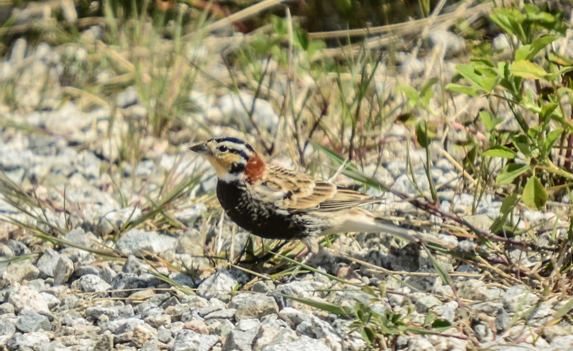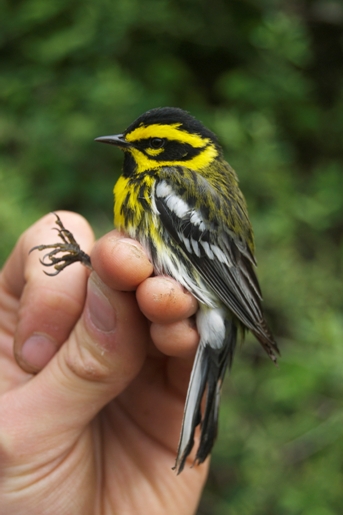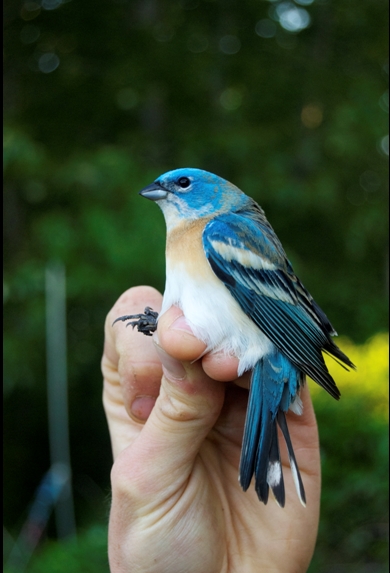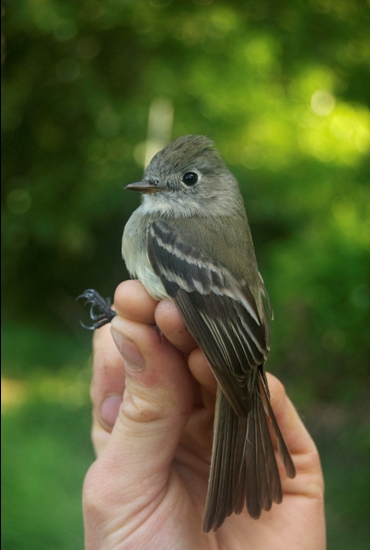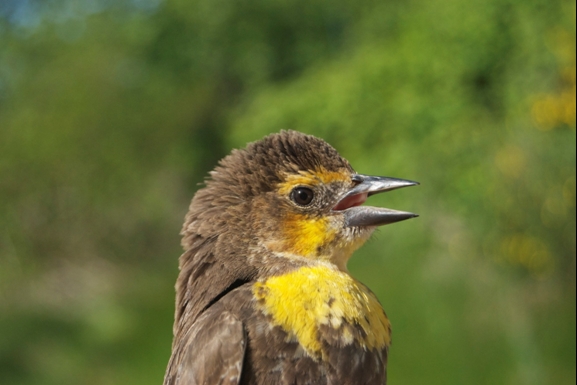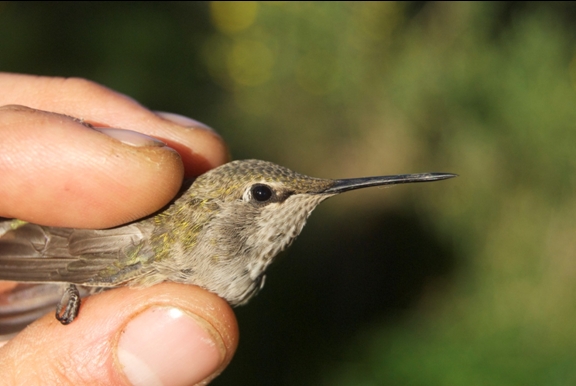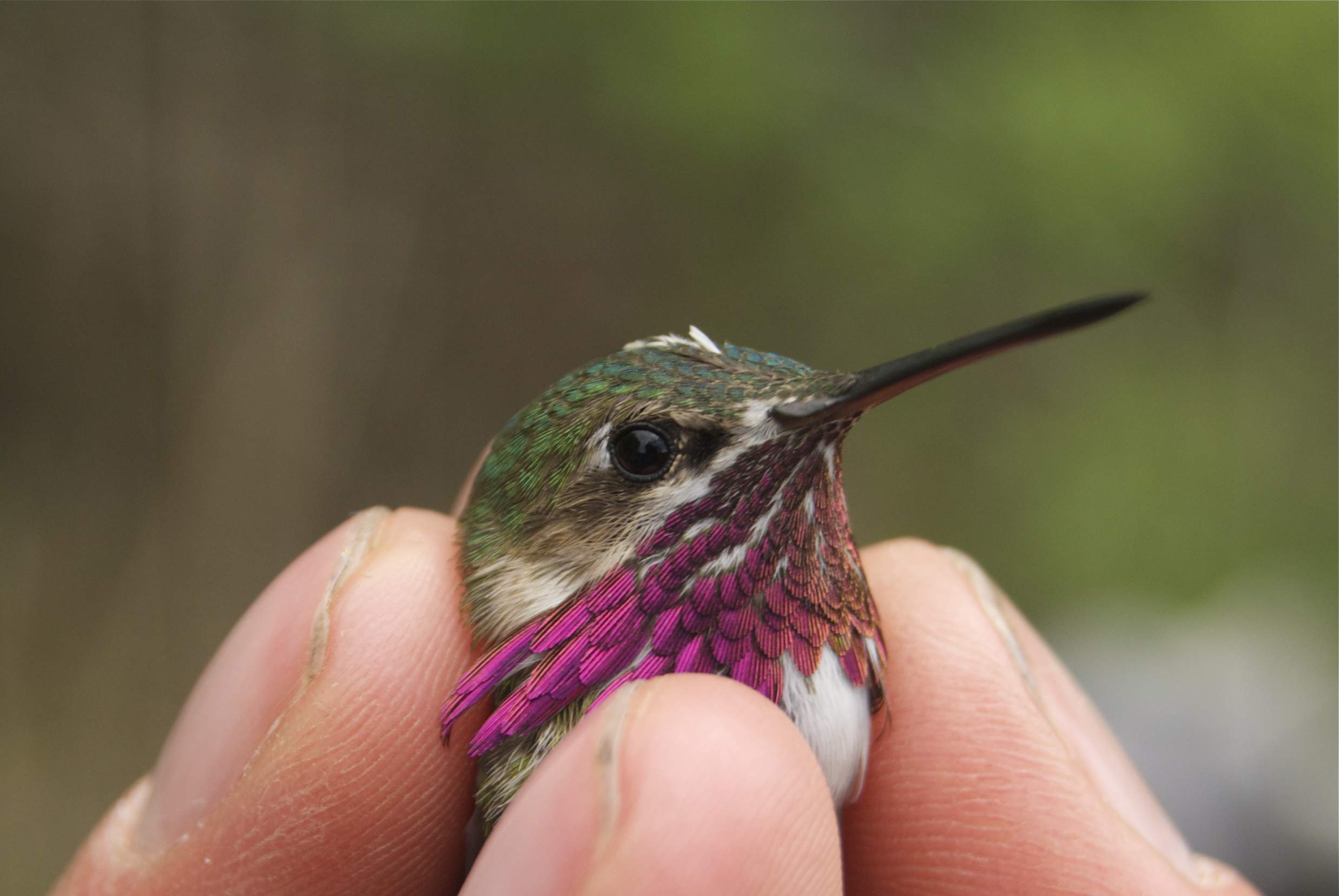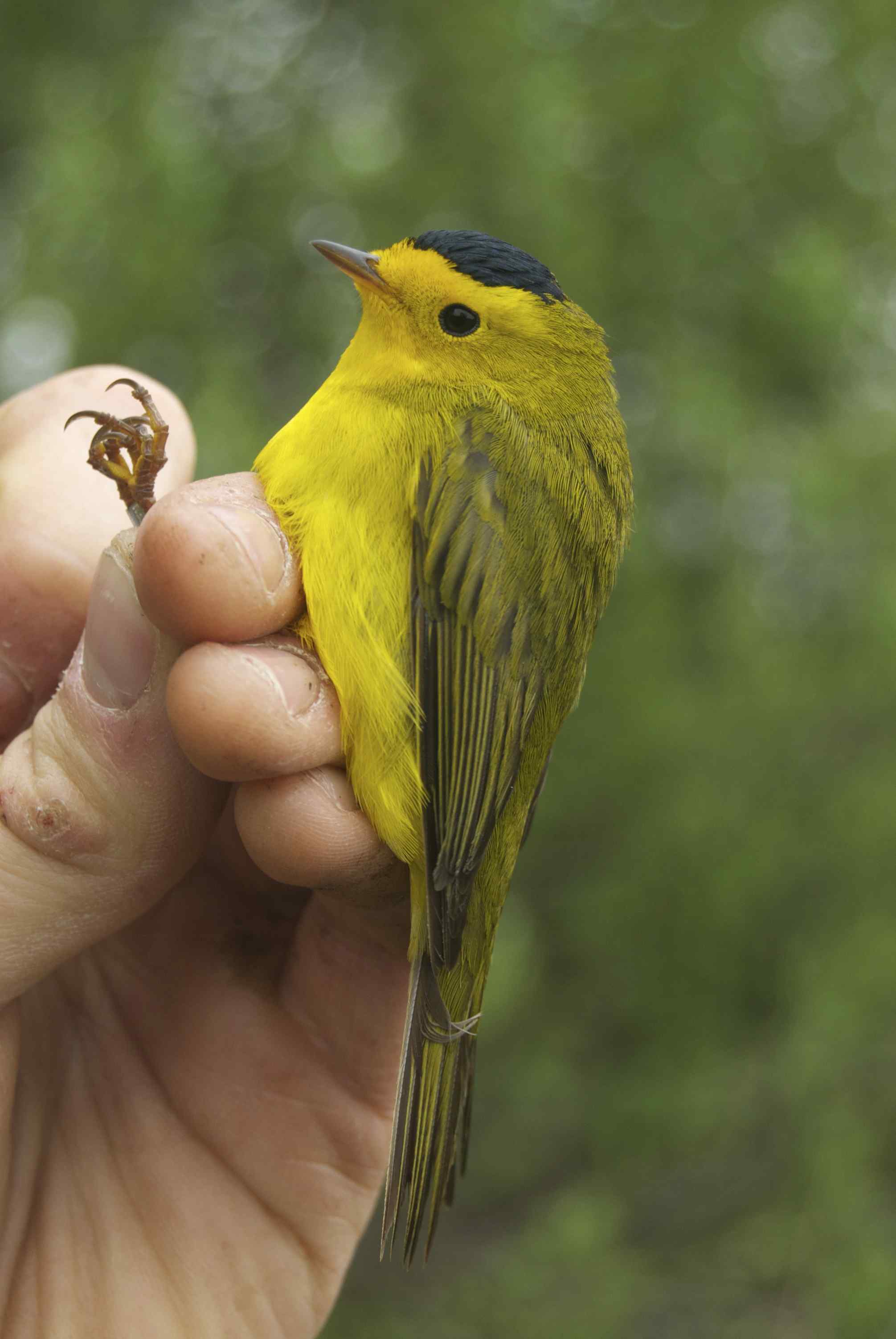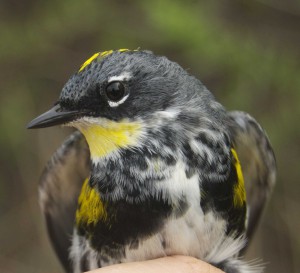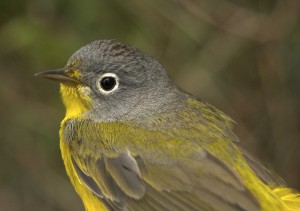May 3rd – 9th, 2012
| Banded | Recaptured | |
| May 3-9 | 759 | 114 |
| Season to Date | 2,280 | 369 |
Chestnut-collared Longspur. (Photo: Torin Heavyside)
The total number of birds banded dropped slightly from last week, but migration has remained very exciting. On May 5th a record breaking 263 birds were banded at IIBO, of which 126 were Myrtle Warblers and 77 were Audubon’s Warblers. Iona Island’s third record of Eurasian Collared-Dove occurred on May 3rd when two birds flew over the station. This species is rapidly increasing in population throughout Metro Vancouver and their presence was not unexpected.
The most exciting bird this week was a Chestnut-collared Longspur that was found by Tak Shabata along the South Jetty on May 7th. This bird was seen and photographed from mid-morning until dusk, but disappeared by the next morning and hasn’t been seen since. This is the first record for Iona Island, and only the second record for the Vancouver checklist area; the first since 1981.
Waterfowl migration has slowed down considerably this week. Aside from the resident Canada Geese, the only migrant geese seen were Greater White-fronted Geese on the 3rd. Diving ducks have been seen regularly in low numbers on most days, and Redheads have been present in the sewage lagoons from May 6th – 9th. Dabbling duck numbers have dropped since the beginning of the week, with the exception of Cinnamon Teal, which have become a regular visitor to the outer ponds. Another sign that waterfowl migration is waning, was the presence of the first young of the year for Canada Geese on May 4th and Mallards on May 8th.
Shorebird migration has slowed down this week as well, although a few new migrants were seen from the count area. IIBO’s first Semipalmated Plover and Spotted Sandpipers of the spring were seen and heard on May 8th and a flock of four Whimbrel flew over the outer ponds on the evening of May 7th. Western Sandpipers and Dunlin numbers have fallen drastically whereas Least Sandpipers have been moving through steadily all week. In addition, Semipalmated Sandpipers have been encountered several times since May 5th.
The first Vaux’s Swift of the year was seen on May 6th and the first Cedar Waxwings were seen the day before. Purple Martins became increasingly abundant after the 5th, including a high count of 26 on May 7th. Trees Swallows were easily the most abundant swallow species this past week, while the other swallows have continued to push through in low numbers. Kinglet migration has virtually finished, with only one Golden-crowned Kinglet seen this week and fewer than three Ruby-crowned Kinglets seen each morning. American Pipits were encountered on the 4th, 5th, and 7th this week and the first Warbling Vireo of the spring was banded on May 7th. At least one Sora was seen and heard intermittently over the last week and a pair of American Bitterns were seen sitting in the north outer pond on May 6th.
Townsend’s Warbler. (Photo: Jeremiah Kennedy)
Warbler diversity increased this week, with a season high of 8 species encountered. Although they seem to be slowly declining, Yellow-rumped Warblers were still the most abundant warbler each morning this past week. Close to 1,300 Yellow-rumped Warblers were seen around the outer ponds on May 3rd. Orange-crowned Warblers increased in numbers later in the week and the first of the orestera subspecies (found in the interior) this spring was banded on May 8th, along with 26 individuals of the lutescens subspecies. Wilson’s Warblers have increased to about 40 individuals counted on most mornings this past week, and Townsend’s and Yellow Warblers made their first appearance at IIBO on the 8th.
May 3rd had the highest number of White-crowned Sparrows so far this season, with 6 banded and 34 counted. Fox Sparrows have not been seen after May 3rd, and Lincoln’s Sparrows have steadily declined after 19 were reported also on the 3rd. The first female Yellow-headed Blackbird of the year was seen on the evening of May 7th and Brown-headed Cowbirds were much more abundant this week with 20 counted on May 7th and 37 seen on the 8th.
Posted: June 16, 2012
May 17th-May 23th, 2012
| Banded | Recaptured | |
| May 17-23 | 200 | 40 |
| Season to Date | 2741 | 478 |
White-throated Sparrow. (Photo: Jeremiah Kennedy)
This week started much like last week, with little diversity and few birds banded, as only 4 birds banded and 5 recaptured in the first three days of the week put together. Unsettled weather moved in on the 20th, and migration was once again easier to monitor. By the 23rd we had banded 200 more birds and recaptured 40.
A few interesting captures came later in the week. The station’s first Lazuli Bunting and third Dusky Flycatcher were both caught on May 23rd. The first White-throated Sparrow this spring was banded on May 20th and four Parasitic Jaegers were seen chasing Caspian Terns on the same day.
A Brewer’s Sparrow was discovered next to the Vancouver Airport on May 21st and up to a hundred Pectoral Sandpipers were present in the Sewage Lagoons for most of the week. Finally, the second breeding record for Caspian Terns in British Columbia was confirmed not far from Iona, on May 21st. Several eggs have been spotted, although it seems as though most of the parents are having little success with protecting them.
There was a little more waterfowl diversity this past week. Canada Goose numbers were on the increase, with flocks moving past fairly regularly on a daily basis. These birds are likely molt migrants of non-reproductive birds from populations further south, that will migrate to areas in the arctic to undergo their prebasic molt.and Both Blue-winged and Cinnamon Teal were also seen in small numbers throughout the week. Redheads that had been present, disappeared from the sewage treatment plant early in the week, a female Canvasback was present in a small flock of Lesser Scaup on the settling ponds from the 20th to the 23rd.
Lazuli Bunting. (Photo: Jeremiah Kennedy)
Ospreys were present on a daily basis and are likely back on their nest in the Fraser River, and Wilson’s Phalaropes showed up in the sewage lagoons on May 22nd. Black Swifts appeared for the first time this year on the 22nd and over 80 individuals were counted on the morning of the 23rd. The first Common Nighthawk of the year was also seen circling the parking lot before dawn on May 23rd.
Flycatchers have increased late in the week with Western Wood-Pewees, Willow Flycatchers and a Western Kingbird first showing up on May 20th. Bank Swallows moved in, in large numbers on the 23rd with 15 birds counted, ten of which seen on one of the point counts.
MacGillivray’s Warblers increased in numbers near the end of the week with four to five being counted on the 20th, 22nd and 23rd. Yellow Warblers have also steadily increased through the week with a season high of 47 counted on May 20th. Western Tanagers first appeared on May 20th when two were banded. Black-headed Grosbeaks were spotted for the first time this spring on the same day and the second banded at the station was captured on May 23rd.
Dusky Flycatcher. (Photo: Jeremiah Kennedy)
As the last week of migration monitoring at the Iona Island Bird Observatory approaches most of the migrants have now passed their peak, and we are now at the tail end of spring migration. This is demonstrated by the age and sex ratios of the birds we are catching, which are now primarily second-year female birds. During spring migration after second-year males are typically the first to arrive, followed by second-year males and after second-year females earlier than females, and the tail end of migration is usually made up of second-year females. Wet weather early this week could force down some later migrants such as flycatchers, grosbeaks, tanagers, and potentially a rarity or two. So there is the potential we may be able to squeeze a little bit more of spring migration out of May yet.
Posted: May 23, 2012
May 10th-May 16th, 2012
| Banded | Recaptured | |
| May 10-16 | 241 | 69 |
| Season to Date | 2541 | 438 |
Second-year female Yellow-headed Blackbird. (Photo: Jeremiah Kennedy)
Interesting birds abounded this week, however, the number of captures decreased dramatically compared to previous weeks. The decrease started on the 11th when 79 birds were banded, and concluded at the end of the period with only 8 birds banded.
The first interesting bird occurred on May 11th when IIBO’s first Yellow-headed Blackbird was banded. This fantastic capture was followed by IIBO’s second House Wren of the season on the same day, which was singing next to the banding table. Dove diversity increased with at least one Eurasian Collared Dove heard singing on May 15th and 16th, and a Mourning Dove was heard on May 11th. Two Wilson’s Phalaropes were also reported from the sewage lagoons on the evening of May 15th. A Green Heron circled the woodlot on May 12th and a Bank Swallow was observed flying over the outer ponds also on the same day.
The most exciting and interesting bird of the period however was the second Calliope Hummingbird of the season, another male, captured on May 14th. With this capture, one may wonder how many are missed? Only four Calliope Hummingbirds have been reported this spring in the Greater Vancouver area, two of which have been captured at IIBO. The first young of the year for Anna’s Hummingbirds are out and one was captured on May 14th.
The first Blue-winged Teal of the season arrived on May 14th and small numbers of Cinnamon Teal have been recorded daily over the past week. A Wood Duck flew past the banding table on May 13th and two more were seen on the evening of May 10th. Two late Greater White-fronted Geese flew over the station on May 16th.
The Sora has been heard intermittently over the period, and a Whimbrel was seen flying over the banding table on May 14th. Spotted Sandpipers, Killdeer and Long-billed Dowitchers were seen throughout the period, but most other shorebirds were absent.
Hatch-year Anna’s Hummingbird. (Photo: Jeremiah Kennedy)
Approximately 300 Bonaparte’s Gulls were seen on the mudflats west of the washrooms on May 13th and 600 were present at the same location on the 16th. The first and only Herring Gull of the season was observed on May 13th.
The only flycatcher of the past week was a Pacific-slope Flycatcher heard singing in the woodlot on May 14th, and Warbling Vireos were around in small numbers each day. The first Swainson’s Thrush of the spring was captured on May 12th and Cedar Waxwings were abundant throughout the week.
Yellow-rumped Warbler numbers finally faded out this week with only one seen on the 15th and zero observed on the 16th. Wilson’s and Orange-crowned Warblers have been steadily abundant for the entire week, but both are likely around or just past their migratory peak and will begin to decrease in numbers. Yellow Warbler numbers have increased to around 20 per day during the second half of the week, and should continue to increase over the following week or two as we move closer to their migratory peak. IIBO’s only Black-throated Gray Warbler of the season was seen on May 11th and three MacGillivray’s Warblers were heard singing on May 15th.
Two to three female Yellow-headed Blackbirds have been present with the three to four males all week and four Red Crossbills were heard and seen flying over the outer ponds on May 13th.
Posted: May 16, 2012
April 26th-May 2nd, 2012
| Banded | Recaptured | |
| April 26-May 2 | 796 | 106 |
| Season to Date | 1521 | 255 |
Male Calliope Hummingbird Caught on May 2nd. (Photo: Jeremiah Kennedy)
The most exciting birds of the past week were a male Calliope Hummingbird captured on May 2nd and a House Wren on April 27th. This is the second record of Calliope Hummingbird at IIBO and the third hummingbird species this spring. The House Wren was the first record at IIBO; it was heard singing for most of the morning on the 27th, but it has not been subsequently relocated.
Waterfowl migration has slowed down this week, but remained diverse. Cinnamon Teal, a pair, were seen on the outer ponds on April 26th, and male Ruddy Duck, still in winter plumage, was seen on May 1st. Flocks of up to several hundred Cackling and Greater White-fronted Geese have been seen, but overall their numbers have been decreasing. The Sora, present since the winter, was last heard on the 28th and the resident Virginia Rails have quieted down considerably as they have likely begun nesting.
Shorebird migration has been in full swing this past week, with large numbers of Dunlin, Least and Western Sandpipers observed daily either on the mudflats or flying over. Numbers peaked on the 26th, with 2000 Dunlin and 500 Western Sandpipers. In addition, a Long-billed Dowitcher was detected on May 2nd and Black-bellied Plovers have been heard on most days. Gull and tern numbers have begun to wane, as Bonaparte’s Gulls and Common Terns haven’t been seen since the 25th, and Caspian Tern numbers have declined to only 2 on May 1st.
Flycatchers and vireos have yet to appear in abundance, as only a handful of Hammond’s Flycatchers have been seen over the last week. Five species of swallow have been observed, including at least six Purple Martins that have returned to their nest boxes on the Fraser River, and several hundred Barn, Violet-green, and Tree Swallows foraging on the outer ponds.
Kinglets have almost finished migrating through, as numbers have diminished to only a handful of Ruby-crowned Kinglets by the end of the week. The first American Pipits of the season were seen on April 27th and the first Cedar Waxwings were heard vocalizing on May 2nd.
Yellow-rumped Warbler numbers have not decreased since the last week’s massive movement. The largest numbers were on April 28th, when a huge fallout of descended upon IIBO. By the end of the morning 191 were banded and over 2000 were estimated to have passed through the area. Large numbers have been detected every day this week, with over 100 banded on both April 27th and May 2nd. Most other days would have seen similar numbers if the weather had been more cooperative. This has truly been a phenomenal sight to see, as rarely does one get the treat of seeing an entire area saturated with warblers for so many days in a row.
Numbers of Wilson’s Warblers continued to build towards the end of the week, with 17 individuals captured on the 1st and 41 on the 2nd. This species will likely continue to build over the next couple of weeks. IIBO’s second Nashville Warbler of the season was banded on the 29th and another one was heard singing between the outer ponds on May 2nd.
Wilson’s Warbler. (Photo: Jeremiah Kennedy)
Sparrow migration has been gradually decreasing, but larger flocks of Savannah, Golden-crowned, and White-crowned Sparrows were present on the 28th-30th in the more open areas. A Western Meadowlark was seen near the washrooms on May 2nd, and at least four Yellow-headed Blackbirds have returned to the north outer pond. The male Yellow-headed Blackbirds are most frequently seen or heard on the island of reeds in the middle of the pond or along the west end of the pond.
Posted: May 2, 2012
April 18th-25th, 2012
| Banded | Recaptured | |
| April 18-25 | 725 | 149 |
| Season to Date | 725 | 149 |
The 2012 Spring Migration Monitoring Program at the Iona Island Bird Observatory (IIBO) started on April 18th. Initially, the capture rate was about average, but soon increased substantially, with IIBO’s busiest day yet on the 24th with 217 banded and 49 recaptured of 24 species.
Audubon’s x Myrtle Warbler Hybrid. (Photo: Jeremiah Kennedy)
By the start of spring season swallow migration was already well under way. Violet-green Swallows were present in large numbers over the first few days of monitoring, with 14 individuals banded and 768 individuals estimated to be present in the area on the 18th. Violet Green Swallow numbers have dwindled since then and only three were present on the 21st. Tree swallows have been present in good numbers all week along with a handful of Cliff, Northern Rough-winged and Barn Swallows. The first Purple Martins arrived on the 22nd and at least a dozen have been present since then.
Warbler movement has remained steady throughout the week, with the highest numbers on the 23rd and 24th. One hundred and fifty warblers of six species were banded on the 23rd, the bulk of which were Yellow-rumped Warblers, with a fairly even mix of Audubon’s and Myrtle Warblers. An estimated 1,400 Yellow-rumped Warblers also passed through the count area on the 23rd. The first Common Yellowthroats were heard on the 19th and the first Orange-crowned Warblers arrived on the 21st. On the 23rd and 24th a male McGillivray’s Warbler was present and Wilson’s Warblers were first recorded on the 24th and 25th as well. The highlight of the season so far was IIBO’s first banded Nashville Warbler, a male banded on the 24th.
Nashville Warbler. (Photo: Jeremiah Kennedy)
The first Hermit Thrushes of the season were banded on the 21st and have been captured in increasingly large numbers each consecutive day since then. A major kinglet push took place on the 22nd, with 36 Ruby-crowned and 19 Golden-crowned banded. Both kinglets have been present in slightly smaller numbers between the 23rd – 25th. Lincoln’s and Savannah Sparrow numbers peaked on the 22nd, while Song, Fox, Golden-crowned, and White-crowned Sparrows have been trickling through since the 18th as well. A Vesper Sparrow was also seen feeding beside the sewage lagoon on the 25th.
A pair of Wood Ducks were seen circling the woodlot and heading into the sewage lagoons on the 22nd and two Ruddy Ducks have been present in the ponds since the 20th. Two Cinnamon Teal were seen in the north outer pond as well as the sewage lagoons on the 25th. Bonaparte’s Gulls peaked early in the week, whereas the Caspian Terns are steadily increasing in numbers on a daily basis with over 200 on the 23rd and 24th and over 350 on the 25th. Around 20 Common Terns flew past and landed on the beach on the 25th.
Shorebird migration has been increasing since the start of monitoring, with a handful of Least and good numbers of Western Sandpipers moving through the count area. Over a thousand Dunlin have been present most days, but on the 25th around 6000 Dunlin, accompanied by close a thousand Western Sandpipers passed over the woodlot on their way from the sewage lagoons to the beach. Other shorebird highlights include a Long-billed Curlew seen and heard flying over on the 22nd, a Wilson’s Snipe banded on April 20th, and a Solitary Sandpiper was found in the sewage lagoons on the 25th.
Three species of geese were regularly seen migrating past IIBO over this first week. Though Snow Geese were common at the start of the monitoring period, none have been seen since the 18th. Greater White-fronted Geese on the other hand have been seen regularly since the 22nd and were most abundant on the 24th with 152 birds counted landing on the Fraser River. Cackling Geese have been seen intermittently and peaked on the 24th with an estimated 150 individuals seen.
A Sora has been present on the north outer pond at IIBO since early February and has been relocated twice this week (22nd and 24th). An American Bittern has been seen regularly since the 18th and the Yellow-headed Blackbirds first arrived on the 22nd and have been conspicuous and vocal ever since.
Posted: April 25, 2012
